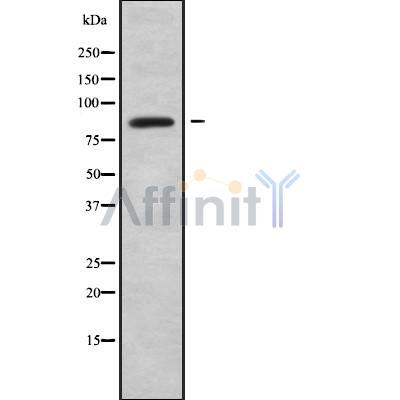ABLIM1 Antibody - #DF9145
| Product: | ABLIM1 Antibody |
| Catalog: | DF9145 |
| Description: | Rabbit polyclonal antibody to ABLIM1 |
| Application: | WB IHC IF/ICC |
| Reactivity: | Human, Mouse |
| Mol.Wt.: | 88 kDa; 88kD(Calculated). |
| Uniprot: | O14639 |
| RRID: | AB_2842341 |
Related Downloads
Protocols
Product Info
*The optimal dilutions should be determined by the end user.
*Tips:
WB: For western blot detection of denatured protein samples. IHC: For immunohistochemical detection of paraffin sections (IHC-p) or frozen sections (IHC-f) of tissue samples. IF/ICC: For immunofluorescence detection of cell samples. ELISA(peptide): For ELISA detection of antigenic peptide.
Cite Format: Affinity Biosciences Cat# DF9145, RRID:AB_2842341.
Fold/Unfold
ABLIM 1; ABLIM; abLIM-1; ABLIM-L; ABLIM-M; ABLIM-S; ABLIM1; ABLM1_HUMAN; Actin binding double zinc finger protein; Actin binding LIM protein 1; Actin binding LIM protein family member 1; Actin-binding double zinc finger protein; Actin-binding LIM protein 1; Actin-binding LIM protein family member 1; DKFZp781D0148; FLJ14564; KIAA0059; LIM actin binding protein 1; LIMAB 1; LIMAB1; Limatin; MGC1224; MGC125264; OTTHUMP00000020530; OTTHUMP00000020531; OTTHUMP00000020532; OTTHUMP00000020533; OTTHUMP00000020534; OTTHUMP00000020535; OTTHUMP00000020536; OTTHUMP00000020537; RGD1565768; RP11-317F20.1;
Immunogens
A synthesized peptide derived from human ABLIM1, corresponding to a region within N-terminal amino acids.
Detected in liver, heart, skeletal muscle, brain and retina, where it is concentrated in the inner segment and in the outer plexiform layers.
- O14639 ABLM1_HUMAN:
- Protein BLAST With
- NCBI/
- ExPASy/
- Uniprot
MPAFLGLKCLGKLCSSEKSKVTSSERTSARGSNRKRLIVEDRRVSGTSFTAHRRATITHLLYLCPKDYCPRGRVCNSVDPFVAHPQDPHHPSEKPVIHCHKCGEPCKGEVLRVQTKHFHIKCFTCKVCGCDLAQGGFFIKNGEYLCTLDYQRMYGTRCHGCGEFVEGEVVTALGKTYHPNCFACTICKRPFPPGDRVTFNGRDCLCQLCAQPMSSSPKETTFSSNCAGCGRDIKNGQALLALDKQWHLGCFKCKSCGKVLTGEYISKDGAPYCEKDYQGLFGVKCEACHQFITGKVLEAGDKHYHPSCARCSRCNQMFTEGEEMYLQGSTVWHPDCKQSTKTEEKLRPTRTSSESIYSRPGSSIPGSPGHTIYAKVDNEILDYKDLAAIPKVKAIYDIERPDLITYEPFYTSGYDDKQERQSLGESPRTLSPTPSAEGYQDVRDRMIHRSTSQGSINSPVYSRHSYTPTTSRSPQHFHRPGNEPSSGRNSPLPYRPDSRPLTPTYAQAPKHFHVPDQGINIYRKPPIYKQHAALAAQSKSSEDIIKFSKFPAAQAPDPSETPKIETDHWPGPPSFAVVGPDMKRRSSGREEDDEELLRRRQLQEEQLMKLNSGLGQLILKEEMEKESRERSSLLASRYDSPINSASHIPSSKTASLPGYGRNGLHRPVSTDFAQYNSYGDVSGGVRDYQTLPDGHMPAMRMDRGVSMPNMLEPKIFPYEMLMVTNRGRNKILREVDRTRLERHLAPEVFREIFGMSIQEFDRLPLWRRNDMKKKAKLF
Research Backgrounds
May act as scaffold protein (By similarity). May play a role in the development of the retina. Has been suggested to play a role in axon guidance.
Cytoplasm. Cytoplasm>Cytoskeleton.
Note: Associated with the cytoskeleton.
Detected in liver, heart, skeletal muscle, brain and retina, where it is concentrated in the inner segment and in the outer plexiform layers.
Research Fields
· Organismal Systems > Development > Axon guidance. (View pathway)
Restrictive clause
Affinity Biosciences tests all products strictly. Citations are provided as a resource for additional applications that have not been validated by Affinity Biosciences. Please choose the appropriate format for each application and consult Materials and Methods sections for additional details about the use of any product in these publications.
For Research Use Only.
Not for use in diagnostic or therapeutic procedures. Not for resale. Not for distribution without written consent. Affinity Biosciences will not be held responsible for patent infringement or other violations that may occur with the use of our products. Affinity Biosciences, Affinity Biosciences Logo and all other trademarks are the property of Affinity Biosciences LTD.

